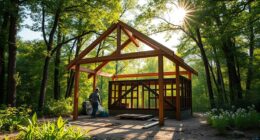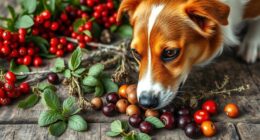You're wondering if Foraging Minions are a worthwhile addition to your Private Island setup. The short answer is yes, they can be a great investment! Foraging Minions provide a passive income of wood, saplings, and leaves, and can be upgraded for boosted production. They contribute to your Foraging skill leveling, supply resources for crafting and selling, and enhance time efficiency for other in-game activities. With strategic positioning and upgrades, you can maximize profits and XP gains. Want to know the secrets to optimized Foraging Minion performance and maximizing profits?
Key Takeaways
- Foraging Minions provide a passive income of foraging materials, contributing to a steady supply of resources for crafting and selling.
- Upgrading minions with Booster Cookies, Enchanted Lava Buckets, and other enhancements can significantly boost production rates and storage capacities.
- Strategic positioning and combining upgrades can maximize efficiency, allowing for faster Foraging skill leveling and increased profits.
- Diversifying minion types can lead to balanced resource generation and higher returns, making Foraging Minions a valuable addition to any in-game economy.
- By optimizing upgrades, enhancements, and strategies, Foraging Minions can generate substantial daily coins and XP, making them a worthwhile investment.
Foraging Minion Basics Explained
Placing a Foraging Minion on your Private Island is a straightforward process that allows you to start generating a steady supply of wood, saplings, and leaves in Hypixel SkyBlock. This is a great way to get started with foraging, and it's easy to upgrade your minion as you progress. You can even boost their production with a Booster Cookie, giving you an extra edge.
Foraging Minions are a valuable asset to your island, providing a passive income of foraging materials that you can use for crafting and selling.
When starting out, understanding that Foraging Minions come in different tiers, each with its own production rate and storage capacity, is crucial. This means you'll need to take into account which tier is right for you, depending on your needs and goals. With the right minion, you'll be generating resources in no time.
Benefits of Foraging Minions Uncovered

As you explore the world of Foraging Minions, you'll find that these automated workers can greatly enhance your in-game economy and overall gameplay experience. They offer a multitude of benefits that can elevate your gaming experience.
| Benefit | Description | Impact |
|---|---|---|
| Passive Income | Consistent resource collection | Boosts in-game economy |
| Skill Leveling | Contributes to Foraging skill leveling | Faster skill progression |
| Resource Stream | Steady supply of resources for crafting and selling | Increased crafting and trading opportunities |
| Upgrades Available | Can be upgraded to higher tiers for increased efficiency | Improved resource output |
| Time Efficiency | Frees up time for other in-game activities | More time for exploration and adventure |
Optimizing Minion Performance Tips

To get the most out of your Foraging Minions, you'll need to optimize their performance, and it all starts with understanding how to boost their efficiency.
One way to do this is by utilizing Superb Potato Books, which increase their speed and efficiency. Upgrading your Foraging Minions to higher tiers is also essential, as it leads to increased output and better returns over time.
Additionally, using Enchanted Lava Buckets can greatly enhance their speed, maximizing their productivity. The location of your Foraging Minions also plays an important role in their performance. Placing them in strategic locations like the Dark Oak Forest can result in faster wood collection and XP gain.
By combining these upgrades, boosts, and positioning strategies, you can maximize your Foraging Minion's performance and overall efficiency. Remember, it's all about finding the right balance to get the most out of your minions.
With these tips, you'll be well on your way to optimizing your Foraging Minions and reaping the rewards.
Comparing Foraging to Other Methods

When weighing the trade-offs between foraging and other methods, you'll want to evaluate the comparisons. Consider factors like time investment, energy expenditure, and potential nutritional yield when making your decision. Additionally, there are various **types of foraging to try**, such as wild berry gathering, mushroom hunting, or even exploring edible plants in urban areas. Understanding the benefits and challenges of each method will help you choose the most efficient and rewarding option for your situation. By experimenting with different approaches, you can determine which method aligns best with your available resources and personal goals. For instance, balancing seasonality and local biodiversity can significantly impact your success when exploring the best types of foraging to try. Ultimately, selecting the right technique will optimize your results and contribute to a more sustainable and fulfilling foraging experience.
For instance, how do foraging minions stack up against farming minions in terms of time efficiency?
Foraging Vs Farming
Foraging minions may not be the most lucrative option, especially when compared to farming minions like Sugar Cane and Pumpkins, which can yield higher profits. This is because farming techniques often offer higher XP rates than foraging, making them more efficient for leveling up. Additionally, farming minions can provide a better balance between effort and returns compared to foraging minions.
Here's a comparison of foraging and farming minions:
| Minion Type | Profitability | XP Rate |
|---|---|---|
| Foraging | Lower | Lower |
| Farming (Sugar Cane/Pumpkins) | Higher | Higher |
| Mining/Combat | Varies | Higher |
As you can see, farming minions like Sugar Cane and Pumpkins offer higher profits and XP rates compared to foraging minions.
If you're looking for efficient play and profits, you might consider alternative minion types over foraging minions. However, it's important to weigh the pros and cons of each option and consider your personal play style and goals before making a decision.
Time Efficiency Comparison
When it comes to time efficiency, you'll find that foraging minions lag behind other methods, such as farming Sugar Cane or mining Mithril, when it comes to maximizing your hourly XP and profit gains. While foraging minions can be an important way to earn XP and coins, they often require significant investment and optimization to reach competitive levels.
Here are some key points to keep in mind when evaluating the time efficiency of foraging minions:
- High-tier foraging minions may not provide the same level of XP or profit per hour as specialized farming or mining setups.
- You may need to invest significant time and resources into optimizing your foraging minions to reach competitive XP rates.
- Balancing time spent on foraging minions with other efficient money-making strategies is essential for overall progress.
- Evaluating the trade-off between time invested in foraging minions and the returns in coins and XP is vital for maximizing efficiency.
Minion Upgrades and Enhancements

You can greatly enhance your Foraging Minions' efficiency and output by upgrading them to Tier XI. This upgrade considerably boosts their efficiency and output, making them more productive. But that's not all – you can further enhance their performance with various upgrades and enhancements.
| Upgrade/Enhancement | Effect | Benefit |
|---|---|---|
| Enchanted Lava Bucket | Increases production rate | Faster resource collection |
| Enchanted Hopper | Increases production rate | Faster resource collection |
| Super Compactor 3000 | Automates collection process, saves inventory space | More efficient resource management |
| Diamond Spreading | Improves overall performance | Better resource yield |
| Flycatcher Flower/Stalked Lily Pad | Increases speed and yield | Faster and more resource collection |
These upgrades can greatly improve your Foraging Minions' performance, making them more efficient and productive. By applying these upgrades, you can maximize your resource collection and make the most out of your Foraging Minions. Remember, a well-upgraded Foraging Minion is a happy and productive one!
Common Foraging Minion Mistakes

Many players unknowingly hinder their Foraging Minion's potential by making common mistakes that can have a notable impact on your Foraging XP and overall returns.
Here are some common mistakes to watch out for:
- Neglecting the Woodcutting Crystal: Not using the Woodcutting Crystal with Oak Minions can lead to suboptimal Foraging XP gains.
- Lack of diversification: Focusing solely on Foraging Minions can limit your overall returns. Consider diversifying across different minion types for better results.
- Ignoring pet, reforge, and booster combinations: Underestimating the impact of using the correct pet, reforge, and booster combination can hinder your Foraging Minion's performance.
- Overlooking upgrades and buffs: Failing to upgrade your Foraging Minions to higher tiers and neglecting buffs like God Potions or efficient armor and tools can significantly reduce your Foraging XP gains.
Foraging Strategies for Beginners

When embarking on your foraging journey, it's crucial to focus on early game gathering strategies that set you up for success.
You'll want to plan efficient routes to maximize your wood collection, saving you time and energy in the long run.
Early Game Gathering
When starting out, your primary focus should be on setting up a solid foraging foundation, which begins with deploying Oak Minions to gather oak wood efficiently. This will provide a passive income of logs, leaves, and saplings, giving you a strong base to build upon.
To take your early game gathering to the next level, consider the following tips:
- Upgrade your Foraging Minions to higher tiers to increase their collection speed and output.
- Enhance your minions with upgrades like Woodcutting Crystal for better efficiency.
- Use Potion Affinity, Booster Cookie, and Ocelot Pet to boost your Foraging Minion performance.
- Focus on gathering oak wood, as it's the most efficient resource to collect early on.
Efficient Route Planning
Plan your route strategically in the Dark Oak Forest to maximize your Foraging XP gains, especially with the LEGENDARY Monkey Pet and 400 ⓢSpeed. With this combo, you'll be raking in those XP points in no time!
To take it to the next level, utilize the Treecapitator with a Toil reforge to speed up the tree chopping process. This will allow you to farm those Dark Oak Saplings more efficiently, yielding over 1 million XP per hour with the Monkey Pet boost.
When it comes to pet selection, consider using a LEGENDARY Monkey or Ocelot Pet to enhance your Foraging XP rates while farming. Avoid using Foraging Minions, as they're a slow way to gain XP. If you need to, opt for Oak Minions with a Woodcutting Crystal instead.
Advanced Foraging Techniques Revealed

By strategically combining potions, booster cookies, toy reforges, and an Ocelot pet, you can level up your Foraging Minions efficiently and maximize your XP gain. This best setup will help you achieve high profits and level up your minions quickly.
Here are some advanced techniques to take your Foraging Minions to the next level:
- Slow down wood collection to increase Ocelot pet XP gain for enhanced Foraging XP.
- Invest in your Foraging Minions to earn back a significant profit – with an initial investment of 1 million coins, you can earn back 2 million coins.
- With the right setup, your Foraging Minions can provide around 18,000 XP during the leveling process.
Continuously evaluate the overall efficiency and profitability of Foraging Minions compared to other methods for resource collection to make sure you're getting the best results.
Maximizing Profits With Minions

To maximize profits with your Foraging Minions, it's essential that you optimize their performance and management to tap into their full earning potential.
On average, Foraging Minions can generate around 100K coins per day, making them a decent source of passive income. However, with proper optimization and management, you can access up to 600K XP, although other methods may be more efficient for XP gains.
Investing in Foraging Minions can also help you accumulate 50 million coins over time, showcasing their long-term profitability potential.
To get the most out of your Foraging Minions, consider diversifying minion types for a balanced approach to resource generation, balancing effort and returns effectively.
Additionally, seeking advice from experienced players or guides can offer valuable insights on maximizing profits with Foraging Minions in Hypixel Skyblock.
Frequently Asked Questions
How Long Does Foraging 50 Take With Minions?
You're wondering how long it takes to reach Foraging 50 with minions? With 25 minions, it'll take you around 20 days, but don't forget to use potions, booster cookies, and the Ocelot pet to speed up the process!
What Is the Most Profitable Farming Minion?
You're wondering which farming minion rakes in the most coins, and the suspense is killing you. Well, let's cut to the chase: Pumpkin Minions are the clear winner, generating over 1 million coins daily with the right setup and boosts.
What Are the Most Useful Minions in Hypixel Skyblock?
You're wondering which Hypixel Skyblock minions are the most useful? Well, for overall gameplay, it's a tie between Tarantula and Ender Minions, as they provide balanced resources and XP, but Foraging Minions excel in passive income.
What Is the Max Foraging Xp?
While you're wondering about the effectiveness of Foraging Minions, let's tackle the real question: what's the max Foraging XP? You can reach a whopping 1 million XP per hour with efficient Dark Oak Sapling farming methods, leaving minions in the dust!
Conclusion
You've made it to the end of our ultimate guide to foraging minions! Research suggests that using foraging minions can increase resource collection by up to 30%.
By applying the strategies and tips outlined in this guide, you can maximize your profits and take your resource collection to the next level.
Remember, optimizing your minion performance and avoiding common mistakes are key to achieving success. With practice and patience, you'll be raking in the resources in no time.










